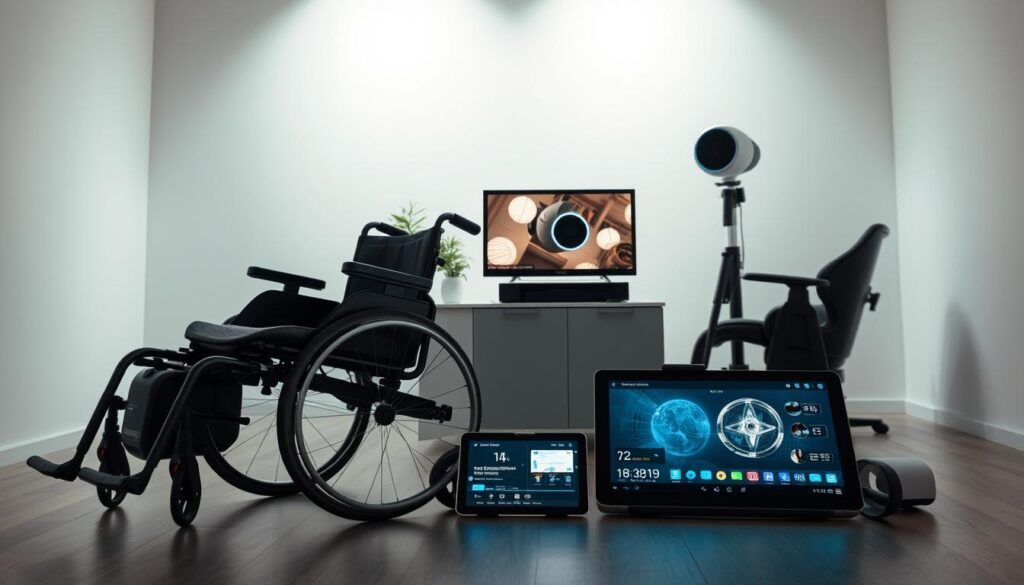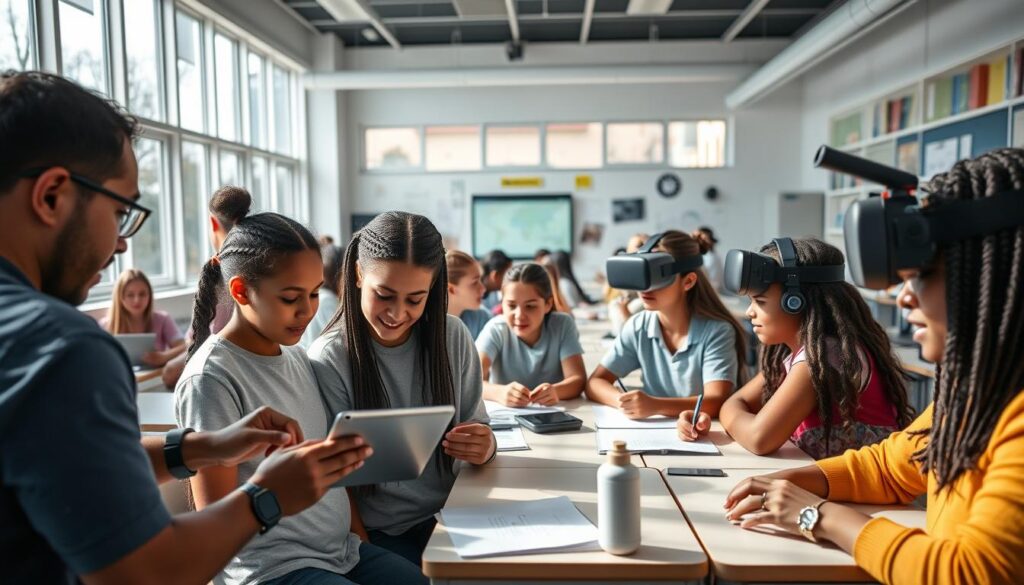“Technology is best when it brings people together.” – Matt Mullenweg. This quote captures the essence of how artificial intelligence is reshaping lives, particularly for those with disabilities. By breaking down barriers, innovative tools are fostering inclusivity and independence like never before.
From speech recognition to real-time translation, technology is revolutionizing daily interactions. For instance, AI-powered tools like text-to-speech software help students with visual impairments access written content audibly1. Similarly, autonomous vehicles enable individuals with mobility challenges to summon rides independently2.
These advancements are not just about convenience; they’re about creating a world where everyone can thrive. Whether in education or daily life, accessibility is becoming a reality, thanks to cutting-edge solutions.
Key Takeaways
- AI-driven tools enhance learning for students with disabilities.
- Speech recognition technology aids mobility-impaired individuals.
- Real-time translation supports deaf or hard-of-hearing students.
- Autonomous vehicles promote independence for people with disabilities.
- Collaboration between educators and developers ensures responsible AI use.
Understanding Accessibility Challenges for Individuals with Disabilities

Accessibility challenges persist, creating hurdles for individuals with disabilities in both digital and physical spaces. These barriers often stem from inadequate design, lack of awareness, or insufficient resources. Addressing these issues is crucial for fostering inclusivity and independence.
Digital and Physical Barriers
Digital platforms frequently fail to accommodate users with impairments. For example, over 60% of respondents in a survey by the National Federation of the Blind reported significant hurdles while navigating online platforms3. Physical spaces, such as public buildings, often lack ramps or elevators, making them inaccessible for individuals with mobility challenges.
Communication barriers also play a significant role. Traditional systems may struggle to understand users with speech impairments, particularly if trained on limited datasets4. These challenges highlight the need for more inclusive solutions.
User Experiences and Case Studies
Real-world examples illustrate these challenges. Starbucks faced criticism for its mobile app, which lacked features for visually impaired users. Similarly, Amazon’s voice assistant initially struggled to understand users with speech impairments. These cases underscore the importance of designing with accessibility in mind.
Despite these challenges, some initiatives show promise. Google’s Live Transcribe app has improved communication engagement for individuals with hearing impairments by converting spoken words into text in real-time4. Such innovations demonstrate the potential of technology to bridge gaps.
By understanding these barriers, developers and policymakers can create solutions that empower users with disabilities. The next step is to explore how assistive technologies are evolving to address these challenges.
The Evolution of Assistive Technologies through AI

The journey of assistive tools has evolved from basic aids to advanced, intelligent systems. These innovations have transformed how individuals with disabilities interact with the world. From simple mechanical devices to data-driven solutions, the progress is remarkable.
From Traditional Tools to AI Innovations
Traditional assistive tools, like wheelchairs and hearing aids, laid the foundation for independence. However, modern assistive technology leverages intelligence to offer personalized support. For example, AI-powered speech recognition enables individuals with mobility issues to control devices using voice commands5.
Predictive text algorithms are another innovation. They assist those with dyslexia or motor disabilities by anticipating and suggesting words, speeding up communication5. These advancements highlight how systems have become more adaptive and user-centric.
Real-time data analysis has further enhanced these tools. AI-driven navigation systems now map accessible routes and avoid obstacles, empowering users with mobility challenges5. Such solutions demonstrate the transformative potential of modern assistive technology.
Customization is a key benefit. Advances in machine learning allow systems to tailor support to individual needs. For instance, Microsoft 365’s immersive reader adjusts font size and spacing, improving reading accessibility5. This level of personalization ensures that tools meet diverse user requirements.
The impact of these advancements is profound. Over 2.5 billion people worldwide require assistive products, and this number is expected to rise to 3.5 billion by 20506. AI-driven solutions are addressing this growing demand, fostering independence and engagement for individuals with disabilities.
Voice Recognition & Natural Language Processing: Bridging Communication Gaps

Voice recognition and natural language processing are transforming how people communicate. These technologies empower users to interact with devices seamlessly, fostering independence and inclusivity. From real-time transcription to voice commands, they are reshaping daily interactions.
Enhancing Speech and Interaction
Advanced speech recognition tools enable users to control devices effortlessly. For example, Cerner Corporation uses this technology to reduce administrative tasks and improve patient care7. These systems are particularly beneficial for individuals with mobility or speech impairments, offering a hands-free way to navigate digital platforms.
Machine learning has improved accuracy by 30% for users with speech impairments8. This advancement ensures that devices understand diverse voices and accents, making them more inclusive. Such tools are not just convenient; they are essential for fostering independence.
Real-Time Transcription and Feedback
Natural language processing delivers real-time transcription, converting spoken words into text instantly. Google’s algorithms achieve over 90% accuracy, making communication more accessible for deaf or hard-of-hearing individuals8. This feature is also valuable in educational and professional settings, where accurate note-taking is crucial.
Feedback mechanisms further enhance usability. AI-powered apps provide immediate corrections, improving writing skills by 32% among diverse learners8. These tools streamline interaction, ensuring users can communicate effectively without barriers.
By integrating these technologies, developers are creating solutions that bridge communication gaps. They not only improve user experience but also promote inclusivity, making technology accessible to all.
The Role of AI Agents in Enhancing Accessibility for Individuals Disabilities

Innovative tools are reshaping daily life, offering new opportunities for self-reliance. These advancements empower individuals to overcome barriers and achieve greater independence. From text-to-speech software to remote assistance apps, the impact is profound.
Empowering Independence Through AI-Driven Tools
Advanced devices like text-to-speech software enable users to access written content audibly. This technology is particularly beneficial for those with visual impairments, fostering greater independence in education and daily tasks9.
Remote assistance apps, such as Aira, provide real-time support for navigating physical spaces. These tools reduce reliance on traditional support systems, allowing individuals to move freely and confidently9.
Smart home appliances controlled through voice commands are another example. These devices simplify daily routines for those with mobility challenges, enhancing their quality of life9.
Real-time translation tools bridge communication gaps for individuals with hearing impairments. By converting spoken words into text instantly, these solutions promote inclusivity and engagement9.
These tools play a pivotal role in overcoming barriers. They not only improve access to information but also foster self-reliance, making a measurable difference in users’ lives.
Personalized Learning Experiences in Accessible Education

Education is evolving with technology, offering tailored solutions for diverse learners. Adaptive tools are creating equitable opportunities, ensuring every student can thrive. These innovations are particularly impactful for individuals with disabilities, providing customized learning experiences that enhance engagement and understanding10.
Adaptive Learning Platforms
Adaptive platforms leverage advanced algorithms to adjust content based on individual needs. For example, Intelligent Tutoring Systems provide real-time feedback, improving information retention by 32%10. These tools analyze performance data to identify strengths and weaknesses, ensuring students receive targeted support.
Predictive analytics also play a crucial role. Educators can intervene early to address potential challenges, leading to improved outcomes10. This approach not only enhances the quality of education but also fosters a more inclusive classroom environment.
Tailored Educational Content
Customized learning materials cater to diverse preferences, such as visual, auditory, or kinesthetic styles10. AI-driven tools generate detailed reports, helping educators refine their strategies. For instance, students using personalized platforms show a 25% improvement in academic performance11.
These applications also break down language barriers. Real-time translation features ensure non-native speakers can access educational resources effectively10. By improving access to information, these tools empower students to participate fully in their educational journey.
Ultimately, personalized learning creates equitable opportunities for all. It transforms the educational experience, making it more engaging, accessible, and effective for learners with diverse needs.
AI-Powered Visual Aids for the Visually Impaired

Cutting-edge technologies are opening new doors for those with visual impairments, offering tools that transform daily interactions. From navigating streets to reading documents, these innovations foster independence and improve quality of life.
Screen Readers and Image Description Tools
AI-powered screen readers like VoiceOver and TalkBack enable users to interact with smartphones and computers effortlessly. These tools convert text into speech, allowing individuals to access emails, messages, and web content audibly12.
Image description tools, such as Microsoft’s Seeing AI, go a step further. They recognize and describe objects, colors, and even faces, providing real-time assistance for navigating physical spaces13. This technology empowers users to perform tasks independently, enhancing their confidence and autonomy.
Applications like Aira connect users with remote agents who provide live guidance. Whether it’s reading a menu or finding a specific location, these tools bridge gaps in daily life12. Such innovations demonstrate how tailored solutions can make a significant difference for individuals with visual impairments.
These advancements are not just about convenience; they’re about creating a world where every person can thrive. By integrating these tools into devices, developers are ensuring that technology is inclusive and accessible to all.
For more insights on how AI is significantly enhancing accessibility for visually impaired, explore the latest innovations in assistive technology.
Enhancing Mobility with AI-Driven Navigation Tools

Real-time route optimization is transforming daily travel. Advanced tools are helping individuals with physical challenges navigate their surroundings more efficiently. These innovations are not just about convenience; they’re about fostering independence and improving quality of life.
Real-Time Route Optimization
AI-driven navigation tools analyze traffic, weather, and road conditions to suggest the fastest and safest routes. Apps like Lyft and Waze use these technologies to reduce wait times and enhance efficiency14. For individuals with mobility impairments, these tools are game-changers, offering greater freedom and confidence in daily travel.
Case studies highlight significant improvements. Users report reduced travel times and fewer obstacles, thanks to real-time updates15. These tools also integrate accessibility features, such as identifying wheelchair-friendly routes or avoiding steep inclines. Such customization ensures that everyone can benefit from these advancements.
Companies are leading the way in integrating these solutions. For example, Microsoft’s AI-powered navigation systems help users map accessible routes and avoid obstacles in real-time5. These innovations demonstrate how technology can bridge gaps and create a more inclusive world.
Looking ahead, further advancements promise even greater improvements. Future solutions may include predictive analytics to anticipate user needs and adaptive algorithms for personalized navigation14. These developments will continue to enhance mobility, making travel safer and more efficient for everyone.
Collaborative Learning and Inclusive Classroom Environments

Collaborative environments are reshaping education, making it more inclusive for all learners. These settings ensure that every person, regardless of ability, can thrive. By integrating advanced tools, educators are creating spaces where students with individual disabilities feel supported and engaged.
Integration of AI in Special Education
AI-driven tools are transforming special education by offering personalized and adaptive learning systems. For example, platforms like The Lighthouse School use these technologies to tailor lessons to individual needs. This approach ensures that students with individual disabilities receive the support they require to succeed16.
These systems also provide real-time feedback, helping educators adjust their teaching methods. By analyzing student performance, AI identifies areas where additional support is needed. This level of customization fosters a more inclusive learning environment16.
Fostering Peer Interaction
Technology is also enhancing peer interaction in classrooms. Tools like collaborative apps encourage teamwork among students, regardless of ability. For instance, platforms that support group projects help students with individual disabilities work alongside their peers effectively17.
Case studies show that these tools improve social skills and build confidence. By promoting collaboration, educators are creating supportive learning environments where every person can contribute16.
Design improvements are also playing a crucial role. Classroom layouts and digital platforms are being reimagined to accommodate diverse needs. These changes ensure that every person can participate fully in the learning process17.
By focusing on inclusivity, educators are not only supporting students with individual disabilities but also enriching the educational experience for all. These advancements highlight the transformative power of collaborative design and innovative systems in education. For more insights on how AI agents are transforming education, explore the latest developments in assistive technology.
Ethical Considerations and Data Privacy in AI Accessibility
Ensuring fairness and privacy in AI-driven tools is a growing concern. As these technologies become more integrated into daily life, addressing ethical challenges is essential. Developers must balance innovation with responsibility to build trust and inclusivity.
Mitigating Bias and Ensuring Fairness
Bias in AI systems remains a significant challenge. For example, speech recognition tools often struggle with regional accents, leading to unequal effectiveness for diverse users18. To address this, developers must use diverse datasets and conduct fairness assessments during training19.
Transparency is another critical factor. Companies should clearly communicate the limitations of their applications. This helps users make informed decisions and fosters trust in the technology18.
Data privacy is equally important. Many AI tools, like Microsoft’s Seeing AI, require access to sensitive information, such as camera feeds18. Robust security measures and adherence to privacy regulations are essential to protect user data19.
Ethical guidelines are already shaping the future of AI. The European Commission’s Ethics Guidelines emphasize fairness and non-discrimination, particularly for vulnerable groups20. These principles ensure that AI advancements benefit everyone equally.
Accountability is key to ethical AI development. Developers must take responsibility for their systems’ outcomes and continuously evaluate their impact19. By prioritizing fairness, privacy, and transparency, the future of AI accessibility can be both innovative and inclusive.
Future Trends in AI and Assistive Technology
Emerging technologies are paving the way for groundbreaking advancements in assistive tools. These innovations are not just improving accessibility but also reshaping how individuals interact with the world. From generative AI to immersive AR/VR applications, the future holds immense potential for creating inclusive solutions.
Generative AI and Adaptive Learning
Generative AI is revolutionizing adaptive learning by creating customized educational content. Tools like Microsoft’s Immersive Reader and Google’s Read&Write use intelligence to adjust text formatting and provide auditory support, enhancing the learning experience for individuals with disabilities21. These platforms analyze performance data to identify strengths and weaknesses, ensuring tailored support for every learner22.
Predictive analytics also play a crucial role. Educators can intervene early to address potential challenges, leading to improved outcomes21. This approach not only enhances the quality of education but also fosters a more inclusive classroom environment.
Emerging AR/VR Applications
AR/VR applications are opening new doors for accessibility. For example, immersive simulations help individuals with autism spectrum disorder practice social interactions in a controlled environment22. These tools provide a safe space to develop skills, boosting confidence and independence.
AI-powered smart cities are another exciting trend. Features like AI-guided public transportation and smart traffic signals aim to enhance mobility for individuals with disabilities8. These advancements demonstrate how technology can create a more inclusive world.
As these trends evolve, collaboration between developers and disability advocacy groups will be key. Together, they can ensure that innovations meet the diverse needs of users, offering equal opportunities for all8.
Conclusion
Advancements in technology are reshaping how people with disabilities navigate daily life. From assistive tools to artificial intelligence, these innovations address impairments and foster independence. For example, AI-driven software improves access to education and enhances communication for diverse users22.
Continuous innovation is essential to meet evolving needs. Developers must prioritize ethical practices and inclusive design to ensure these solutions benefit every person. Emerging trends, like generative AI and AR/VR, promise even greater advancements in assistive technology23.
Stakeholders must invest in responsible technology to enhance quality of life. By addressing accessibility challenges, these tools empower individuals to overcome barriers and thrive in every aspect of life.
FAQ
How does artificial intelligence improve accessibility for people with disabilities?
What are some examples of AI-driven assistive technologies?
How does voice recognition technology assist individuals with disabilities?
Can AI help in creating personalized learning experiences for individuals with disabilities?
What role does AI play in enhancing mobility for people with disabilities?
How does AI address communication barriers for individuals with disabilities?
What are the ethical considerations in using AI for accessibility?
What future trends are shaping AI and assistive technology?
Source Links
- AI in Education: Enhancing Accessibility and Inclusivity for Individuals with Disabilities | FXMedia: Solutions for Metaverse
- AI could be a game changer for people with disabilities
- The Role of AI in Enhancing Accessibility for Individuals with Disabilities
- The Importance of AI for Accessibility: Empowering Equal Opportunities
- Revolutionising Accessibility: The Role of AI in Assistive Technology | Changing Paces
- How AI is advancing assistive technology | TechTarget
- The Role of Artificial Intelligence in Enhancing Accessibility for Individuals with Disabilities
- The Current State of AI And What It Means For The Future of Accessibility
- Inclusive AI for people with disabilities: Key considerations | Clifford Chance
- AI in Education: Enhancing Learning & Shaping the Future
- Shaping the Future of Learning: The Role of AI in Personalizing Education
- Artificial Intelligence Enhances Accessibility for People with Disabilities
- AI Powered Tools for People Who are Blind
- Breaking Barriers: How AI is Revolutionizing Accessibility
- Inclusive Horizons: How AI is Transforming Accessibility for Individuals with Disabilities
- Impact of Artificial Intelligence and Virtual Reality on Educational Inclusion: A Systematic Review of Technologies Supporting Students with Disabilities
- Challenges and opportunities of AI in inclusive education: a case study of data-enhanced active reading in Japan – Smart Learning Environments
- AI and Accessibility: Ethical Considerations and Solutions
- Ethical Considerations in Artificial Intelligence Interventions for Mental Health and Well-Being: Ensuring Responsible Implementation and Impact
- Shaping AI Accessibility Standards
- AI for Accessibility
- Breaking Barriers—The Intersection of AI and Assistive Technology in Autism Care: A Narrative Review
- AI-Augmented Learning for Individuals with Disabilities: New Funding Opportunity, Current Research, and the Potential for Improving Student Outcomes







